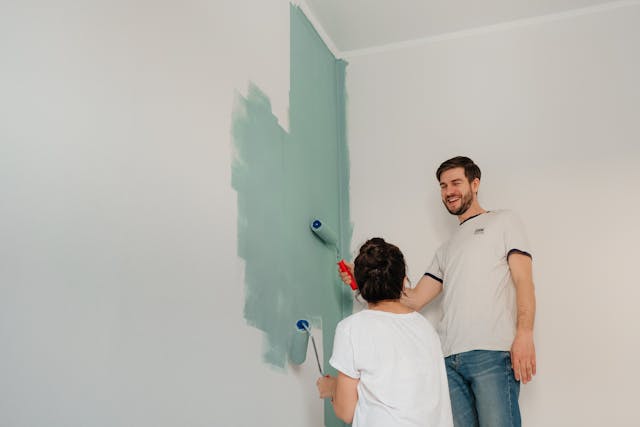I couldn't be happier with Lyndsey and her team. From the initial phone conversation right through to the closing and management they have always been there with sound advice and prompt service. As an out of town investor it is very comforting to know that they are there 24/7 looking after both my investment and my tenants.
.png)
Key Takeaways
- Set Clear Boundaries in the Lease: Include specific clauses about painting permissions, approved colors, and repainting responsibilities to protect your property and avoid disputes.
- Choose a Policy That Balances Control and Flexibility: Whether you say no, offer conditional approval, or allow full freedom, align your approach with your property goals and tenant expectations.
- Communicate Early and Document Everything: Always get painting agreements in writing, review local regulations, and maintain open communication to ensure compliance and protect your investment.
At Fall River Property Management, we understand that tenants sometimes want to make their rental unit feel more like home, often starting with a fresh coat of paint.
While neutral colors remain the industry standard for their broad appeal and ease of maintenance, some renters seek a more personalized touch. As a landlord, how you handle these painting requests can directly impact tenant satisfaction and your property’s long-term value.
This guide explores the pros and cons of allowing tenants to paint, outlines practical solutions, and helps you navigate the legal and logistical considerations.
With clear policies and a balanced approach, you can protect your investment while creating positive landlord-tenant relationships.
Contact Us Today
Should Landlords Allow Tenants to Paint?
Tenants sometimes offer to handle the painting themselves, including covering the cost of paint, tools, and labor. At first glance, this may seem like a win, it saves you time and money. But if they’re asking you to provide materials or do the work, you have several responses to consider.
Here are three main options for landlords:
Option 1: Declining the Request Politely
You’re well within your rights to deny a tenant’s request to repaint the rental. If maintaining a uniform, neutral interior is your policy, it’s completely reasonable to say no.
Just make sure to communicate your decision clearly and respectfully to avoid unnecessary tension. To soften the rejection, offer alternatives, such as removable wallpaper or peel-and-stick wall decals.
These options allow tenants to express their style without making permanent changes. Be sure to emphasize the importance of using high-quality, damage-free products and discuss any expectations for removal at the end of the lease.

This approach helps preserve your unit’s marketability for future tenants while minimizing maintenance costs between occupancies.
Option 2: Approving the Request With Conditions
If you’re open to allowing tenants to paint but want to safeguard your investment, granting conditional approval is a sensible middle ground. Setting guidelines lets you maintain control over the outcome while offering renters a bit of creative freedom.
Here are key considerations when offering conditional permission:
Color Restrictions
Limit the color palette to a curated selection of approved shades. Neutral tones like soft grays, beiges, and muted blues tend to appeal to a broader market. Avoid letting tenants choose bold, dark, or unusual colors that may deter future renters or require multiple coats to repaint.
Designated Rooms Only
Consider restricting painting to specific rooms, such as bedrooms or living areas, while prohibiting changes in kitchens, bathrooms, or on surfaces like wood trim or paneling. This minimizes restoration work and keeps high-traffic or sensitive areas intact.
Repainting Responsibilities
Clarify from the start who will handle repainting when the lease ends. In many cases, landlords require the tenant to return the walls to their original color before moving out. Be sure this expectation is communicated in writing.
Check your local landlord-tenant laws to ensure this condition is enforceable. You may also want to adjust the security deposit to account for potential repainting costs, especially if allowing more personalized colors. By providing clear boundaries, you support tenant autonomy while protecting the rental’s value and future appeal.

Option 3: Allowing Painting Without Restrictions
Taking a hands-off approach and allowing tenants to paint freely may help foster goodwill and promote long-term tenancy. This flexibility can be especially appealing to renters who value personalization and may reward your trust with extended stays and better care of the property.
However, this approach does carry risks. Tenants might choose colors that make the space harder to rent later or neglect proper repainting upon moving out.
To prevent surprises, have an honest conversation upfront about expectations. You can still offer recommendations or suggest using paints that are easy to cover later.
This option works best for landlords who prioritize tenant satisfaction over strict control or for properties where uniqueness adds value rather than diminishes it.
Learn How to Maximize Your Home's Potential
Key Factors to Consider Before Approving Repainting
No matter which path you choose, consider these important elements before allowing any painting to begin:
Lead Paint Disclosure (For Older Properties)
If your rental was built before 1978, federal law requires that you disclose any known lead-based paint hazards. In these cases, a tenant may request repainting due to health or safety concerns, especially if the existing paint is peeling or chipping.
Even if your property was constructed after 1978, it's still wise to stay informed and maintain oversight of any repainting project. Tenant safety and legal compliance should always be top priorities.
Unauthorized Painting
If a tenant paints without your approval, you have legal grounds to require them to restore the unit to its original condition. This may involve deducting repainting costs from their security deposit, provided the lease includes a clause that prohibits unauthorized alterations.

To prevent misunderstandings, clearly state in your lease agreement that any painting or changes to walls must receive prior written consent. This helps set expectations and provides a basis for addressing noncompliance if needed.
Lease Clauses to Protect Your Investment
To avoid complications and reduce risk, it's wise to include specific language in your lease regarding painting and alterations. This section should cover:
- Whether tenants must seek written approval before painting.
- Approved color palettes or finish types.
- Which rooms or surfaces may be painted.
- Who is responsible for repainting or restoring walls at lease-end.
- Consequences of unauthorized painting.
By outlining these details in advance, you ensure all parties are on the same page and prevent unnecessary conflict.
Bottom Line
Tenant painting requests are a common part of property management, and how you respond can significantly impact your rental experience.
A firm “no” helps preserve your property's value and streamlines turnovers.
A conditional “yes” offers flexibility while maintaining control. And an open “yes” may enhance tenant satisfaction but often comes with added oversight and potential costs.
No matter your policy, success lies in clear communication, consistent enforcement, and well-documented agreements. Always review local regulations, ensure your lease reflects your stance, and put all decisions in writing.
Need expert guidance to navigate decisions like these? Fall River Property Management is here to help. Contact us today to learn how we can simplify your rental management and protect your investment.